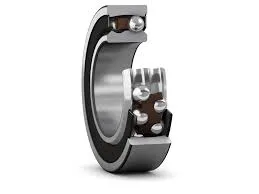
Oct . 17, 2024 10:11 Back to list
shielded thrust bearing
Understanding Shielded Thrust Bearings An Essential Component in Modern Engineering
In the world of mechanical engineering, bearings play a crucial role in the efficiency and reliability of machinery. Among various types of bearings, the thrust bearing is especially significant. It is designed to handle axial loads, which are forces that act parallel to the shaft's axis. One innovative variant of this component is the shielded thrust bearing, which incorporates additional features aimed at enhancing performance and longevity.
What is a Shielded Thrust Bearing?
A thrust bearing is primarily known for its ability to support axial loads, which can originate from various sources, including gears, shafts, and even heavy machinery. A shielded thrust bearing takes this concept a step further by including protective shields that guard against contaminants. Typically composed of metal and sometimes featuring polymer materials, these shields prevent debris, dust, and moisture from entering the bearing assembly. This added layer of protection is crucial for applications where operating conditions may be harsh.
The Mechanism Behind Shielded Thrust Bearings
Shielded thrust bearings consist of two main components the races and the rolling elements, which can be balls or rollers. The races are the surfaces that guide the rolling elements, facilitating smooth motion while distributing the load. The shields act as barriers, ensuring that the lubricants used within the bearing do not escape while simultaneously preventing foreign particles from causing wear or operational failure.
The lubricants used in shielded thrust bearings are paramount to their efficiency. They minimize friction between moving parts, reduce heat generation, and prolong the life of the bearing. By creating a sealed environment—thanks to the shields—these bearings can maintain their lubrication more effectively, which is particularly beneficial in high-load applications.
Applications of Shielded Thrust Bearings
shielded thrust bearing

Shielded thrust bearings find applications across a wide range of industries. They are commonly used in automotive components, such as in the transmission systems where axial loads are prevalent. Machinery in manufacturing settings—like presses and mixers—also benefits from these bearings due to their ability to withstand various external factors, including heavy loads and exposure to lubricants and coolants.
In aerospace engineering, where precision and reliability are paramount, shielded thrust bearings ensure that critical systems—such as landing gear and engine mechanisms—operate smoothly under extreme conditions. Their ability to maintain performance despite challenging environments makes them a standard choice in safety-critical applications.
Benefits of Using Shielded Thrust Bearings
The advantages of shielded thrust bearings are numerous. Foremost among these is their enhanced durability. The protective shields significantly reduce contamination, which is a leading cause of bearing failure. As a result, industries utilizing these bearings can expect longer replacement cycles, reduced downtime, and ultimately, cost savings.
Additionally, shielded thrust bearings exhibit improved performance consistency. The seals help to retain lubricant, ensuring the components remain lubricated even during intermittent operation. This stability leads to reduced friction and heat buildup, contributing to greater energy efficiency.
Another vital benefit is ease of maintenance. With reduced contamination, the frequency of inspections and preventative maintenance can be lowered. This aspect is particularly valuable in large-scale operations where resource allocation is a concern.
Conclusion
In summary, shielded thrust bearings represent a vital innovation in the field of mechanical engineering, providing enhanced protection and performance for applications subjected to axial loads. Their design not only safeguards against contaminants but also helps maintain lubrication, ensuring longevity and reliability in various industrial settings. As technology continues to advance, the need for such improved components will only increase, underscoring the importance of shielded thrust bearings in modern engineering applications. Whether in automotive, manufacturing, or aerospace industries, these bearings provide an essential balance of performance and protection, making them indispensable to the machinery that drives our world.
Latest news
-
Premium Deep Groove Ball Bearings | High Speed & Reliability
NewsAug.29,2025
-
Durable Scaffolding Clamps - Secure & Reliable Tube Connectors
NewsAug.28,2025
-
Common Failures in Thrust Ball Bearings and Solutions
NewsAug.22,2025
-
How Tapered Roller Bearings Can Take Shock Loads
NewsAug.22,2025
-
Angular Bearings in High-Precision Spindles
NewsAug.22,2025
-
The Impact of Misalignment on Cylindrical Roller Bearing Performance
NewsAug.22,2025
